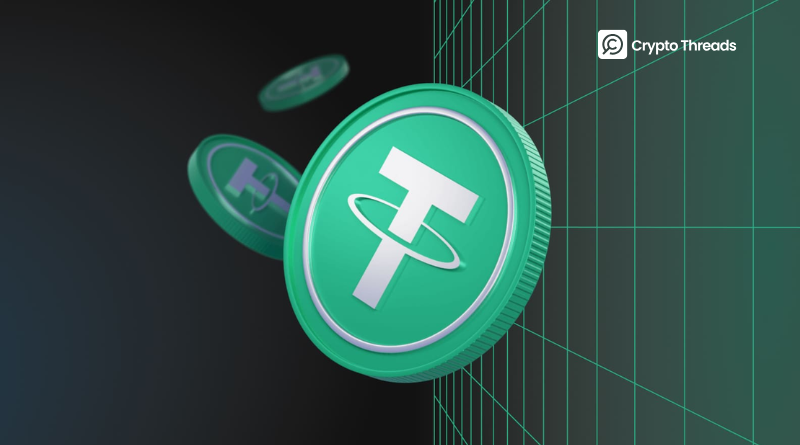Tether: Transformation in the Face of Legal Changes
Tether’s Special Position
To understand why Tether’s recent moves are so significant, we need to look back at the company’s development journey. Tether is more than just a stablecoin issuer, it has become the backbone of the global cryptocurrency ecosystem.
When Bitcoin emerged in 2009, the cryptocurrency world lacked a stable bridge between highly volatile cryptocurrencies and the traditional financial system. This is precisely when USDT appeared as a perfect solution. Rather than converting Bitcoin to USD through slow and costly bank processes, traders could use USDT as a “digital dollar” to transfer value efficiently on the blockchain.
Imagine USDT as a sturdy bridge spanning the volatile river of the cryptocurrency market. One side holds the unpredictable crypto space, while the other represents the stable but slow-moving traditional financial world. USDT enables users to operate on the blockchain’s speed while preserving the stable value of the US dollar.
The success of this model is demonstrated through impressive numbers. Currently, USDT has a market capitalization of over $158 billion, capturing about 70% of the global stablecoin market share. Daily, USDT’s trading volume regularly exceeds $50 billion, often higher than Bitcoin on many days. This shows that USDT has become the main artery of the entire cryptocurrency ecosystem.
However, this outstanding success has put Tether in a dilemma. When a company becomes so important that it can affect the entire financial system, regulators cannot sit idle. This is precisely why the GENIUS Act and similar regulations are being pushed forward worldwide.
The GENIUS Act – A Silent Revolution in Stablecoin Management
The introduction of the GENIUS Act has significantly impacted all stablecoins, including Tether. Beyond being just a legal document, the GENIUS Act represents a judicial system shift in how the world views stablecoins. To understand the impact this law creates, let’s examine these provisions in detail.
100% Reserve Requirement – Lessons from the Terra Luna Crisis
The provision requiring 100% reserves in highly liquid assets is not an arbitrary regulation. This is an expensive lesson from the collapse of Terra Luna and UST in May 2022. UST, an algorithmic stablecoin, lost its peg and collapsed in just a few days, dragging down the entire Terra Luna ecosystem worth tens of billions of USD.
Unlike UST, which relied on complex algorithmic mechanisms, USDT is said to be backed by real assets. However, Tether’s reserve composition has long been a mystery. According to the latest financial reports, Tether’s reserves include not only cash and government bonds, but also commercial paper, corporate bonds, and even Bitcoin and gold.
Imagine Tether’s reserves as a safe. The GENIUS Act requires this safe to contain only “extremely safe” assets like cash and short-term government bonds. Meanwhile, Tether’s current reserves resemble a diversified investment portfolio, including assets that can be highly volatile like Bitcoin. When markets experience volatility, the value of these assets can drop sharply, threatening the ability to maintain a 1:1 ratio with USD.
Audit Requirements – Transparency vs Trade Secrets
One of the most controversial provisions of the GENIUS Act is the requirement for independent audits and detailed information disclosure. This is not a simple matter for Tether.
For many years, Tether has refused to conduct full audits according to international standards, instead only publishing “attestation” reports—a much simpler form of verification. The company justifies that revealing too much information could expose trade secrets and create security risks.
However, from the perspective of users and regulators, this lack of transparency is creating suspicion. If Tether truly has sufficient reserves as claimed, why not readily allow independent auditors to verify? This is like a bank refusing to let inspectors check its vault.
Comparison with Circle and the USDC coin
To better understand the challenges Tether faces, we can compare it with Circle—the company issuing USDC, USDT’s biggest competitor.
Circle has long adopted a strategy of complete transparency. The company regularly publishes detailed audit reports, clearly listing each investment in its reserves. USDC’s reserves mainly consist of cash and short-term US government bonds—exactly what the GENIUS Act requires.
Moreover, Circle has proactively cooperated with US regulators, obtaining necessary licenses in many states. Meanwhile, Tether is registered in the British Virgin Islands, a jurisdiction known for more relaxed regulations.
Interestingly, despite USDC being much more compliant, USDT still maintains its leading position with double USDC’s market share. This shows that in the cryptocurrency market, liquidity and practical applicability remain more important than compliance. However, when regulations like GENIUS are enforced, this balance could change completely.
Tether Faces Its “Kodak Moment”
The situation Tether is facing can be compared to a “Kodak moment”—when a market-dominating company suddenly faces fundamental industry change.
Kodak was the “king” of the film photography industry for over a century. However, when digital technology exploded, Kodak couldn’t adapt in time and eventually filed for bankruptcy in 2012. Ironically, Kodak had invented the first digital camera in 1975, but didn’t dare “self-cannibalize” its profitable film business model.
Tether stands before a similar situation. The company can continue clinging to its old business model—maintaining opacity about reserves and avoiding regulators. Or it can proactively change to adapt to the new legal environment. But changing means abandoning many competitive advantages the company has built over many years.
Paolo Ardoino, CEO of Tether, seems to have recognized this. In a recent interview, he acknowledged: “We can’t keep doing things the old way forever. The world is changing and we have to change with it.”
Tether’s Diversification Strategy: Lessons from Samsung and Amazon
Tether’s response to compliance pressure is not unique. Throughout business history, many companies have adopted similar diversification strategies when their core industries faced challenges.
How Samsung Reinvented Itself to Survive Market Shifts
Samsung started as a small grocery store in Seoul in 1938. When the agricultural market faced difficulties, the company gradually expanded into many other fields: insurance, securities, retail, and finally electronics. Today, Samsung Electronics is just one part of the giant Samsung conglomerate with dozens of subsidiaries operating in industries from shipbuilding to real estate.
Amazon’s Evolution: Building a Digital Empire from Books
Amazon started as an online bookstore in 1994. But Jeff Bezos realized early that just selling books wouldn’t be enough to build a sustainable business empire. The company gradually expanded into general retail, then logistics, and finally cloud computing with AWS—currently Amazon’s most profitable business segment.
Tether is applying a similar strategy, but with unprecedented speed and scale in the cryptocurrency industry.
Analysis: Tether’s Expansion
Building a Closed Ecosystem
Bitcoin Mining Sector – Vertical Integration Strategy
Tether’s heavy investment in Bitcoin mining is not coincidental. This is a smart vertical integration strategy, similar to how Apple controls the entire production chain from chip design to final product assembly.
By investing in Bitdeer with a 21.4% stake, Tether is not only diversifying its investment portfolio but also ensuring a stable Bitcoin supply for its reserves. Currently, Tether holds over 100,000 BTC, worth about $3 billion. Instead of having to buy Bitcoin from the open market at volatile prices, having a direct supply from mining operations helps the company control costs better.
The open-source mining operating system MOS project also shows larger ambitions. Instead of just participating in mining, Tether wants to shape the entire industry. If MOS becomes an industry standard, Tether will have enormous influence over how miners worldwide operate.
Wallet and Payment Sector
Investments in Zengo and Rumble Wallet show Tether is trying to control the “last mile”—the final point of contact with users. This is extremely important in the context of fierce competition.
Imagine the stablecoin market as a taxi race. Currently, USDT is like the most common type of taxi on the road. But if wallet applications start “encouraging” users to use USDC instead of USDT (possibly through lower transaction fees or easier-to-use interfaces), USDT’s market share could erode quickly.
By investing in wallet developers, Tether ensures that USDT will always be well-supported and have priority in important user interfaces.
Layer 1/Layer 2 – Creating Private “Empires”
Supporting Stable (Layer 1) and Plasma (Bitcoin Layer 2) shows the ambition to create blockchains that “belong to” Tether. Stable uses USDT as its native gas token, meaning every transaction on this network requires USDT. This creates a “mandatory” demand for USDT, independent of user choice.
This is like a country creating its own currency and requiring all domestic transactions to use that currency. If Stable and Plasma attract many users and projects, they will become “mandatory demand sources” for USDT.
Expansion Beyond Cryptocurrency
AI and Technology
Tether’s AI projects like BrainOS, QVAC, and private AI platforms show a far-reaching vision. While many still view Tether as a stablecoin company, Paolo Ardoino is repositioning the company as a “technology conglomerate” with multiple business segments.
The $200 million investment in Blackrock Neurotech is particularly interesting. Brain-computer interfaces are considered one of the most breakthrough technologies of the coming decade. If this technology succeeds, it could completely change how humans interact with computers and the internet.
Imagine in the future, instead of typing or touching screens, you could execute cryptocurrency transactions just by thinking. If Tether has a pioneering position in this technology, they could create completely new competitive advantages in the digital payments industry.
Agriculture
The investment of over $615 million in Adecoagro may seem unrelated to cryptocurrency, but is actually very smart. Agriculture is one of the industries least affected by economic cycles. No matter how the cryptocurrency market fluctuates, people still need to eat.
Moreover, Adecoagro doesn’t just produce agricultural products but also has sugar and ethanol plants. In the context of the world moving toward renewable energy, bioethanol could become a very large market. This could be Tether’s “angel investment” for the next 10-20 years.
Sports and Entertainment – Brand Building
Investments in Juventus and media companies have different purposes than technology investments. This is a brand-building strategy and creating indirect marketing channels.
Juventus has hundreds of millions of fans worldwide. When Tether becomes a major shareholder of the club, they have the opportunity to reach a huge audience. This is especially important as social media platforms like Facebook and Twitter increasingly restrict cryptocurrency advertising.
Risk Analysis
Despite many bright spots in Tether’s diversification strategy, it also harbors significant risks.
- Financial Risk
Within a year, Tether has invested billions of USD in completely different sectors. This could lead to being “spread too thin”—when resources and focus are scattered too much.
Conglomerate discount is a phenomenon observed in stock markets, where multi-industry conglomerates often have lower valuations than the sum of their individual parts’ values. The reason is that investors believe management cannot effectively operate too many different industries simultaneously.
- Management Risk
Tether was founded and developed as a fintech company. Suddenly expanding into agriculture, sports, and AI requires completely different knowledge and experience. Despite being able to hire experts, building culture and management processes for new sectors is a major challenge.
- Legal Risk
Each industry Tether enters has its own legal regulations. Instead of only having to comply with cryptocurrency regulations, Tether now faces agricultural law in Argentina, sports law in Italy, technology law in many different countries. This significantly increases costs and complexity in legal



